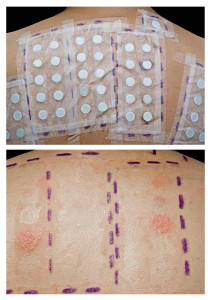When I was a kid, Mum dragged me to the dreaded naturopath who told us I shouldn’t be having wheat or dairy. As a result, Mum started waging war against these evils in my diet, and also against me, because at the age of 10 there was no way I was going to eat soy milk soaked rice flakes that tasted like soggy cardboard and that horrid, savoury old-school soy milk taste.
After just a few months she had to give up. I revolted ever time we went back to see the poor naturopath, refusing to speak to her, and also making every attempt to get my hands on wheat and dairy at the slightest opportunity. Compliant, sweet child, wasn’t I? Who would have thought I’d end up a naturopath!
 Nowadays we really are spoilt for choice, with a wide variety of delicious low allergenic options. And this brings me to my blog topic today: ‘allergies’ are becoming more and more common. In fact, if I had 10 friends round for dinner I’d estimate that at least 7 of them would be avoiding some food item or another. So how do you know if you are eating a food that is affecting your health? Well it might come down to symptoms, or to some testing. But before we explore these areas, we need to understand what exactly food ‘allergies’ are.
Nowadays we really are spoilt for choice, with a wide variety of delicious low allergenic options. And this brings me to my blog topic today: ‘allergies’ are becoming more and more common. In fact, if I had 10 friends round for dinner I’d estimate that at least 7 of them would be avoiding some food item or another. So how do you know if you are eating a food that is affecting your health? Well it might come down to symptoms, or to some testing. But before we explore these areas, we need to understand what exactly food ‘allergies’ are.
Food Allergies- IgE Mediated Reactions
The easiest way to think of a true food allergy is to think of someone who is allergic to peanuts or seafood. If they eat or come in contact with the food they get an immediate and severe reaction.
Technically it is called an IgE-mediated reaction. IgE is a class of antibody that makes up the immune system in mammals. IgE plays an essential role in type 1 hypersensitivity reactions which present as various allergic diseases including allergic asthma, sinusitis, allergic rhinitis and some types of chronic dermatitis. IgE also plays a pivotal role in anaphylactic reactions to certain drugs, foods and bee stings.
The reaction occurs immediately after contact, and is easy to detect with symptoms such as abdominal cramping, diarrhoea, hives, rashes, swelling wheezing and anaphylaxis.
What I am getting at here, is that this type of allergy isn’t something you spend a long time guessing about. You might eat a peanut, have your lips swell and tingle and then vomit. This happens again the next time you eat a peanut, and the next. By now you know you don’t want to be eating peanuts. You don’t usually need a test to tell you, you are allergic to peanuts. More than likely, you will always be allergic to peanuts, and you’ll never be able to eat them. The allergy is static.
 Food Intolerances- IgG Mediated Reactions
Food Intolerances- IgG Mediated Reactions
This is the type of ‘allergy’ that most naturoapths deal with. It is in fact, not an allergy. It is an intolerance. In IgE allergies, we saw that the allergy is fixed, you’d most likely always have it. In an IgG intolerance, it is possible to heal the body of these intolerances and return the food to the diet. Not in 100% of intolerances, but in the weaker reactions, this is entirely possible.
Again, IgG is a different class of antibody, making up the immune system. It is involved in type 2 and 3 hypersensitivity reactions which can occur hours or days after the exposure to the offending food. This is what makes these intolerances difficult to detect. Testing is often the best way to identify IgG intolerances, as often the foods patients are reactive to comes as a surprise. It may be something the patient really enjoys, or even craves.
Unlike IgE antibodies, the IgG antibodies can affect any organ or tissue in the body. This allows for a wide variety of symptoms, with the most common being bloating, fluid retention, inflammatory bowl disease (IBD), inflammatory bowl syndrome (IBS), irritable bowel syndrome, migraines, depression, mood swings, asthma, skin conditions and behavioural problems in children (possibly what my naturopath was going on!).
As you can see, it is easy to think your migraines don’t have anything to do with the food you eat. But perhaps, 2 days prior to the onset, you ate the offending food. It is highly unlikely that you remember or make this correlation as 2 days ago was a long time when it comes to thinking about what you ate.
The good thing about these intolerances, is that once you have identified the offending food/foods, you can go ahead and avoid those foods. After a minimum of 6-8 weeks of total avoidance, the immune complexes have left the body and your symptoms should be much better. With slight intolerances, these foods may be reintroduced into the diet on an occasional or rotational basis. For stronger intolerances, once every few months may be all you can consume without symptoms.
After testing, I know myself to have a strong intolerance to dairy (that darn naturopath was right!!!). If I avoid dairy in my daily life, and consume it only on rare and special occasions, I can usually get away with waking the next day feeling pretty good. But if I over indulge (like at Christmas time), I will start waking with blocked sinuses, puffy eyes and a fuzzy head. That is the signal that my body has had enough. So, let’s look now at testing!
I regularly have people coming in to clinic with what I recognise to be food intolerances. When I suggest testing, quite a few will say they have already had a skin prick allergy test, and they weren’t allergic to any of the foods I believe to be causing the problem (usually wheat and dairy, my old nemesis’s). This is where they are often mistaken. They may have been IgE allergy tested for wheat and dairy, and no, they have no true allergy to either of these foods, but it does not mean they are not intolerant! So making things difficult, you may be intolerant to wheat but not allergic to it. Please remember this, the allergy test done by your doctor is an IgE test- it has nothing to do with IgG. And it is IgG intolerances that are rapidly becoming common place (another story).
If you suspect and IgE allergy, you can organise skin prick testing through your doctor.
If you suspect IgG intolerances, you will have to see a naturopath or nutritionist, or alternative doctor. IgG tests are carried out through blood samples. Your blood is exposed to the proteins of a variety of foods, and the reaction is noted. If the immune complexes in your blood start mounting a response, you have an IgG intolerance reaction. The speed and strength of the reaction will denote how severe the reaction is, and how strictly you need to avoid this food.
IgG intolerance testing ranges in price from $100-$700 depending on the number of foods you choose to investigate. Please discuss these options with your naturopath if you wish to explore this area further.
I hope that clears up the difference between allergies and intolerances. It is not the easiest subject to understand, and many people are surprised to know these differences exist. Please feel free to ask any questions you may have in the comment box below. 🙂
Rhianna
![]()
Tagged as:
100% raw, allergies, dairy free, energy, food as medicine, happiness, health, IgE, IgG, intolerance, intolerances, testing, vegetarian, wheat free

4 commentsAdd comment
Hi Rhi,
I’ve heard that if you’ve been avoiding a particular food (like gluten or dairy) for a while, it can skew the test and cause it to come up as a false negative. Does that mean in order to get an accurate result, I should eat a little of the foods I’ve been avoiding so there are some immune complexes present in the blood? And if so, how much do I need to have? I’ve been meaning to get tested for a while, but I’m scared I’ll have to eat a whole load of gluten and make myself sick!
Thanks xo
Hi Jules!
Yes this is something that comes up a lot with IgG testing. If you have been avoiding gluten for a long time then you may not have any immune complexes left in the body, and as a result, do not show up reactive to that food.
I would say in this situation, trust your body! If gluten makes you feel sick, you know you have a reaction to it, so is it necessary to see that reactivity proved on paper?
I actually found this exact case in my own IgG test- I came back non-reactive to gluten or wheat, yet I know I feel worse when I eat it. I am still going to avoid it even though the test said I was non-reactive, but seeing that, I know I can have the occasional splurge without freaking my body out too much.
If you want to measure your reactivity by including some of the foods you avoid, and then getting a test, I’d have a small amount (1/2 slice of bread maximum) of the offending substance about 3 weeks prior to testing. See how you feel. If you feel ok, have another small amount a week after, and then the week after- before your test.
That way it will allow your body to build immune complexes before testing.
You don’t need to eat heaps, and if that little bit makes you feel sick, don’t eat any more, and get tested after that single exposure.
Hope that makes it clearer!
Good luck! 🙂
Rhianna 🙂
Yes this can be one thing that comes up lots with immune gamma globulin testing. If you have got been avoiding protein for an extended time then you’ll not have any immune complexes left within the body
It’s good to see that a naturopath could help you to determine whether you struggle from allergies or intolerances. My son struggles to eat certain foods. I definitely think that we should see a naturopath to see if he struggles with any serious allergies.